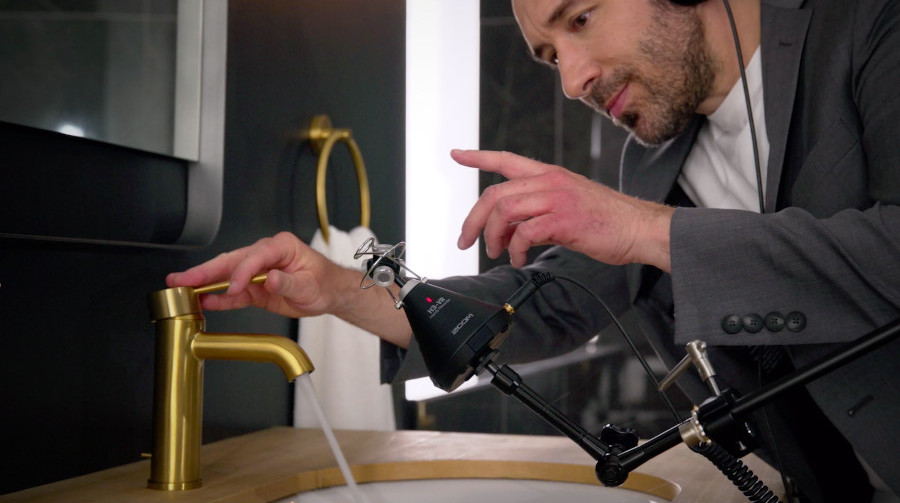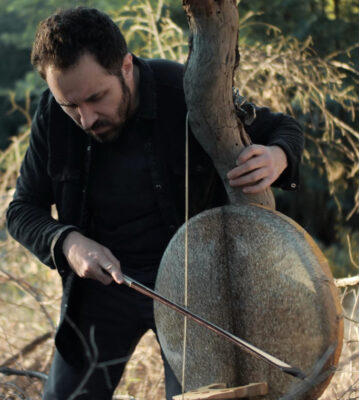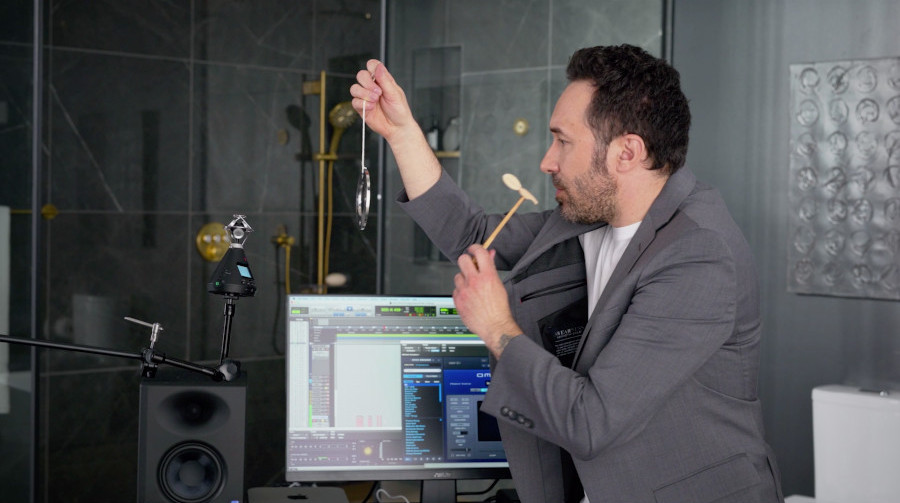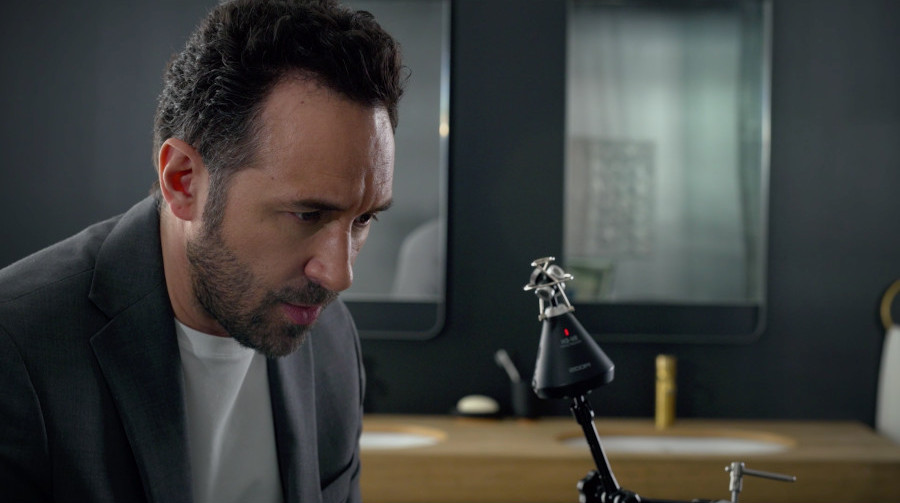How to Record Water: Harnessing Nature in the Studio
How to record water is just the start of what sound explorer Diego Stocco explains about audio.
It’s easy to hear the music in music. But step outside a symphony or 3:00 pop hit, and this sensation suddenly feels challenging.
Unless you’re Diego Stocco, an adventurous “sound explorer” who knows where harmonies are hidden. A prolific Nashville-based sound designer, composer, and instrument inventor, Stocco recently delivered on a project tailor-made for him: the Spa Serenity Playlist.
The four-track set was commissioned by GROHE, a producer of luxury kitchen and bathroom fixtures. On a quest to reflect the universally soothing sounds of running water, GROHE called on Stocco to create Spa Serenity. Each track – “Rain”, “Invigorating”, “Relaxing”, and “Mindfulness” – features exceptionally-well recorded water, woven with sound design to invoke the zen relax of a “dreamshower”.
Stocco’s unique talents at hearing and recording nature are fundamental to the project’s success. He stacks those skills with in-studio expertise, which includes creating multiple virtual instruments for Spectrasonics’ acclaimed Omnisphere and Stylus RMX. His prowess in sampling, and in inventing entirely new musical instruments, fuel his excitement to unlock new performance dimensions.
Best of all, Stocco is glad to share his audio insights. In this SonicScoop interview, he illuminates the deep thought necessary to build branded audio content like Spa Serenity, and produce a transporting experience. He also guides you to a meditative space where you can let go and record without expectations.
Ready to take your own audio career to a refreshingly out-of-the-box place? Read on – Diego Stocco takes you there.
How did you become interested in the field of invented musical instruments — how did this become a primary aspect of your musical creativity and expression?
It came about naturally. I was starting by modifying existing instruments a little bit, or taking them apart to see how they work. When I couldn’t put them back together the same way, I was like, “All right, what do I do with the material? What do I do with these different parts?”
What started as a backup plan, in a way, ended up being a good direction for me to explore. As I became more familiar with the things that I could do – the instruments that I could either modify or build from scratch – it just evolved naturally.
Why is it helpful to take a step back and think about not just how an instrument sounds and how it’s played, but how it actually works and functions? What do you learn from that?
I think you develop a better understanding of the mechanism and sound itself.
Let’s say you take an existing instrument, like a guitar, and you take it apart, and then you try to put it back together. You might realize that a small component actually had a very big impact on the sound. Or you might realize that the choice of strings can have a big impact on the sound. If we’re talking about an acoustic instrument, the wood, the way that it resonates.
Imagine you are modifying a violin or a cello or something, and the sound post falls down – you really realize that that tiny piece of wood actually had a very important role in the sound of the instrument. These things sometimes are inside the instrument, they’re hidden. You don’t realize what they do until you find out what they were, where they were, and what you’re missing now that they’re gone.
Why do you think it is that maybe a lot of musicians and engineers skip that step, and don’t do that extra exploration?
Well, I wouldn’t blame them for doing that. Because obviously, it’s not the most rational thing to do: You go buy a guitar and then you take it apart. When you’re a musician you tend to focus on the performance aspect, what you can do with the instrument, how you interact with the instrument.
When you approach it instead from the perspective of a sound designer or somebody that builds instruments, you want to understand a side of it that has very little to do with the performance. That’s because whether an instrument sounds good is sometimes unrelated to the performance – you can have a quality instrument that’s a quality instrument by itself.
Obviously, in the hands of a skilled player, it’s magnificent. It’s a beautiful thing to hear. But the instrument itself, it’s already great, or not. I think that most musicians go and find something that sings to them just by playing it, that’s the logical approach. But there’s more to it, you can also explore different dimensions of the instrument.
What’s the connection of exploring the makings of physical instruments, and inventing your own instruments to creating sounds for virtual instruments like Omnisphere and Stylus RMX?
There’s a dimension in sampling you can explore that is actually different from what you would call performing. I’m going to make a simplification: You can either sample an instrument to try to replicate that instrument in the most realistic version of it. Or you can use that instrument to completely invent something new.
I tend to do the second (approach). Because to me, it’s the most exciting, the area where I feel like I can really invent something. Let’s say you have an instrument that has only one note, or maybe one way that you can play it. From a performance standpoint, it would be limited. But from a sampling standpoint, there is no limitation.
The moment you bring that sound into Omnisphere, for example, then it can be playable, you can apply additional synthesis to it. Sampling is more like you are performing with a sound, rather than with the music. That’s how I would describe it.
That’s a great way of putting it. That’s how you see your work for Omnisphere and Stylus, for example – this is sample-based work?
Yes. It’s like, “OK, I have these objects, or I have a technique that I want to explore. What can I do with it?” And then it can become a rhythm, in case of Stylus RMX. Or it can become a playable sound in the case of Omnisphere.
Essentially, the idea is that you are becoming closer to the sound itself rather than the performance. I build an object that has a certain sound that I can make by playing in a certain way, that I know that I wouldn’t be able to transform into a traditional instrument like a violin or a guitar. The sound that this thing makes is interesting to me, and so I think it’s worth finding a way to put it into the world – virtual instruments allow you to do that.
What makes Omnisphere and Stylus RMX particularly good venues for you to do that?
I would say the immediacy that you can get out of them. The moment you load up a sound and you play it, you are already transported into whatever world that sound wants to create. There are levels: You can stay on the surface and you can play that beautiful sound, or you can start to go deep into synthesis and you can start changing the sound to whatever you like, and create new ones. But there is no layer where you do nothing: There’s always a layer that you get something out of it.
I obviously love those instruments. I’m obviously biased because I’ve been working on them a long time, but the logical workflow of those instruments is really easy to understand. That’s an important consideration for those who make instruments: “How logical is the workflow of my synthesizer or my instrument?”
Outside the Studio: Recording Nature
We’ve talked about physical and virtual instruments, now let’s talk about nature, another sound source which you’re also very familiar with. What would you say are the unique challenges of recording sounds from nature?
It’s more like accepting what nature can give you. If you are, let’s say, playing a guitar, you have a certain set of expectations that you want to meet: You want a certain range, timbre, volume, and you expect it to go higher and higher the more prestigious and expensive the instrument.
With nature, all these considerations are out of window. You can try playing a tree. And regardless of how beautiful or old, or weird or whatever the tree shape is, you are essentially in the position where, well, this is the sound that I can get. It is up to me to accept it and make something out of it, essentially.
You cannot go and say, “Oh, I think that tree didn’t sound good enough.” Well, yeah, you can play a different tree. But essentially, there isn’t a Guitar Center of trees, so to speak, that you can go and try. It’s truly an experience where it’s about, “Here I am in this environment, what is the environment giving me? And what am I allowing myself to do with that?”
“Do You Hear the Music in it?”
We’ve been talking about nature in general, we’re going to talk about water now and the Spa Serenity Playlist. I was blown away by how the water sounds came through – to me, it really was a completely different level. What were the creative objectives of this project? How did it unfold?
The idea behind it is: Are you just listening to water for what it is? Or do you hear the music in it?
That’s what I want to do. Every little stream of water and the shower heads or the faucets, every single element that could essentially output water was intended to build an instrument. I listen to those elements like instruments. And then because I’m thinking of them in a musical way, I’m also thinking, “This element moves this way, has this kind of range, this kind of motion. I want to combine it maybe with something lower.”
Imagine an orchestra, just to give you a simplification of the concept. You think of that more as, “These are instruments and I’m going to combine them together to say something that is more musical than a traditional noise scale.”
The idea (behind the Spa Serenity Playlist) was to explore the connection between the products themselves, that are really beautifully designed, and the sound that comes out of it. Let’s see how far I can take this element that people would consider to just be water. Well, it isn’t just water to me, it’s a musical sound. I can hear a tone. And if I can hear a tone, then I can map it in Omnisphere and play it. That was the idea.
Can you explain more about what we’re hearing in these tracks, because it’s not just water, right? What did you capture, what are the layers, and how did you construct them?
The water is the main foundation that carries the piece from the beginning to the end. Even in that background there is a musical evolution. There’s a crescendo. It’s not just, “I’m opening the faucet for two-and-a-half minutes.” No, there was an interaction with the water coming out of it, and a buildup that has a logical sense, a musical sense.
I also explored the objects as, “What kind of sounds can I make with them that is not a water sound?” All the pipes, for example, I can blow into them so I can make a note. Those notes either became a musical element that was just standing as it is, like the original note that I play. Or it can also become playable the moment I put it inside Omnisphere.
I did the same thing with what’s inside of the GROHE products. There are washers and other components that you don’t normally see, but they sounded amazing. For example, the piece that is more meditative, “Mindfulness”, you hear all these bells floating around you, blending with the sound of water. All of those sounds were made with these washers that I was just hitting and moving around a little bit, creating space and a sense of motion and everything, and then tapping for percussion sounds.
Essentially, everything that was giving me a sense of tonality was going to be used as elements to create melody and harmony. You have the water, and then everything else also is me interacting with GROHE objects – the faucets, pipes, shower heads…everything.
A Simple Signal Path for Serene Sounds
What was your signal path for recording the water itself in terms of microphones, pre-amps, converters?
Well, you would be surprised that it was the simplest system ever: I was using a simple Zoom H3-VR ambisonics recorder.
I like working with things that don’t get into the way of me performing with the instrument. If I have to work with water, well, then I have to worry about covering the microphones, and it becomes too complicated. These little recorders have the wind filter and everything, but they’re really easy to move around. So if I want to hear the water from this perspective, I’m just pointing at it.
Then I was just importing the sound and started working with it. I went with the least complicated system technologically, because I wanted to be focused on the water side. I wanted to be focused on my interaction with the GROHE products and the overall experience instead of the technology.
In general, I try not to be caught too much into the technology itself, because it really is how you listen and interpret a sound. The microphone choice is important, but it cannot become a limitation. Your ears are way more important.
When you started putting everything together, do you work in Pro Tools? Were there a lot of tracks and stems, or were these relatively simple?
There’s one composition that is the most energetic one, “Invigorating”, that has a rhythm created with multiple water elements. There’s something that sounds like a bass and there’s chords and everything. If you look at the session, it can go into maybe 40 tracks. For other compositions, there were less tracks.
But again, I wasn’t really focusing on, “It has to have more or less tracks.” It was about, “How can I translate the philosophy behind these products into something that people can hear in a musical form?” That was my focus.
Since one of the focuses was on “Serenity,” how do you translate that? How do you produce something that’s a serene listen?
The idea is like if you are under a shower, and you have this shower head that can be fine-tuned to however you like the water to reach you. You relax there.
I was like, “If I’m listening to the music, am I transported there?” That was the idea. How do I feel when I listen to this piece of music? It wasn’t meant to be, “I want a piece of music that takes you to a faraway land.” No, I wanted to create something that takes you under this dimension that is warm, and sound is like water, and so it flows around you.
It’s a very transporting experience that you were going for, but transporting in an inner way.
Right. The idea is that if you close your eyes, you feel the journey is within you. It’s not about the outside, it’s about, “I’m just here relaxing. It feels great. And I just feel in a cocoon of water all around me.”
Follow Your Ears
What advice would you give a hip hop producer, a pop music producer, an engineer for rock who’s reading this and is inspired to move into this kind of recording? What kind of mindset shift do they need to take to go from recording and producing traditional music and sounds into capturing natural or mechanical sounds?
The key is to let the sound talk to you – especially without the expectation of making something, whether it’s great or bad. It’s more like, “First I’m going to let the sound talk to me, then I’m going to take my experience of that into the physical reality.” Then you turn it into something.
The first step is to abandon the idea that you are in control. To a degree, because obviously you are a sound engineer or musician, so you want to put a shape to something. It’s like a sculpture. You can find a block of stone, but you have to create something out of that. It’s essentially the same.
However, if you work with a piece of marble or a piece of limestone, there is already a basic difference in these materials. You need to understand that the material itself has a basic nature that will determine the direction of this project that you do. When you are in that mindset, then I think you can start putting your own ideas or personality into this raw material and give a shape to it. You can imagine what you want out of it.
It sounds like capturing and shaping these sounds from outside the traditional musical realm is a project that every audio engineer should challenge themselves to do, to expand themselves.
At the very least, it would be an experience that takes you to places that you haven’t been before. You can try something different. And then, many times the techniques that I develop for these projects end up being very useful also for other projects, because you learn a lot along the way.
Intuitive Audio Career Advice
Diego, you appear to have had a distinctive career path. What’s your advice for other audio professionals reading this who might want to lead their own non-traditional, out of the box careers?
It’s about finding something that speaks to you, an element that you feel a connection with. Nature is a big theme for my work because I can relate to that. I love materials, I love the sounds of nature. I love the physicality of working with nature.
The moment you start to feel good about something, you’re onto something. If there is something that resonates with you, at the end of the day you go, “You know what? That felt great! It was a great experience.” I think that’s a good indicator that you are connecting the dots between your mind and what’s out there. Obviously, it’s different for everybody. It takes patience.
Based on everything you’ve told me, and the way you listen to water, nature, and what’s around you, it occurs to me to that you must need to turn your ears off at times. How are you able to do that? Is it important for you to unlisten at times, and how do you get that done?
Well, you could try. But the sense of hearing is the only sense that we have that cannot be put on pause. You can close your eyes and you don’t see anything. Even if you close your ears, sound is still going to travel through your body.
I can tell you something funny that happened many years ago: I was listening to the sound of squirrels running on the roof of the house where I was living at the time. And I was thinking, “I cannot sleep.” Because in my mind I was essentially making a catalog. I was like, “Oh, this is the slow run. This is the fast run. This is the mother squirrel.”
I would say, go with the flow this way: If you cannot turn it off, then use it to your own advantage. But in a less poetic way, I would say, “If you need to sleep – earplugs!”
— David Weiss is an Editor for SonicScoop.com, and has been covering pro audio developments for over 20 years. He is also the co-author of the music industry’s leading textbook on synch licensing, “Music Supervision, 2nd Edition: The Complete Guide to Selecting Music for Movies, TV, Games & New Media.” Email: david@sonicscoop.com
Please note: When you buy products through links on this page, we may earn an affiliate commission.













[…] Source link […]
[…] Source link […]